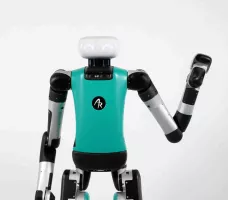Agility Robotics Digit Alternatives & Competitors
Ranked Nr. 8 of 39 Humanoid Robot

Top 10 Digit Alternatives
- Figure Figure 02
- UBTECH Robotics Walker S
- Figure FIGURE 01

Figure Figure 02
Payload 20kgThe FIGURE 02 stands out as the world’s first commercially viable autonomous humanoid robot, with a design that closely mimics the human form. It is 5'6" tall and has a payload capacity of 20 kg, making it capable of performing tasks that require significant strength. The robot is powered by an electric system, which enables it to run for up to 5 hours and move at a speed of 1.2 meters per second. Its human-like hands and limbs are engineered to interact with environments built for people, enhancing its versatility.
FIGURE 02 is designed to perform a wide range of tasks across various industries, thanks to its advanced AI and human-like dexterity. It is capable of opening doors, climbing stairs, and handling tools, making it suitable for complex tasks that go beyond the capabilities of traditional robots. Its ability to lift, carry, and manipulate objects with precision makes it a valuable asset in environments such as manufacturing, logistics, warehousing, and retail.
This humanoid robot is particularly beneficial in sectors facing labor shortages and in environments that are hazardous for human workers. FIGURE 02 can autonomously perform tasks that reduce the need for human presence in unsafe or repetitive jobs. By integrating into existing workflows, it offers a scalable solution to improve efficiency and safety, while also filling gaps in the workforce where human labor is either unavailable or at risk.

UBTECH Robotics Walker S
The UBTech Walker S is an advanced industrial humanoid robot designed for sophisticated manufacturing environments. Standing 1.7 meters tall, it features a robust structure with force-compliant drive joints and a rigid-flexible coupling hybrid system, allowing for stable walking and navigation on mobile production lines. Its all-terrain autonomous adaptation enhances its ability to operate in diverse conditions.
Walker S excels in comprehensive perception, thanks to its 41 servo joints with force feedback, and a range of sensors including visual, audio, and distance inputs. This setup supports its advanced 3D semantic navigation, where high-resolution RGBD sensors help it create detailed 3D maps and navigate safely by avoiding obstacles.
The robot's integration of a large language model (LLM) allows it to understand complex intents and plan finely-tuned actions. Its capabilities extend to advanced object detection and grasping through 3D point cloud processing, enhancing its efficiency in tasks requiring hand-eye coordination. Additionally, Walker S ensures real-time data synchronization with manufacturing management systems, promoting seamless operations across the factory floor.

Figure FIGURE 01
Payload 20kgFigure FIGURE 01 is a humanoid robot designed to function effectively in human-centric environments. It stands at approximately 1.68 meters (5'6") tall and weighs 60 kilograms, with the capability to carry a payload of up to 20 kilograms. This robot is powered electrically and offers a runtime of up to 5 hours, with a top speed of 1.2 meters per second. Its human-like form factor is strategically chosen to facilitate interaction with environments that are typically designed for human occupation.
The design rationale behind FIGURE 01 centers on the utility of a humanoid shape that mirrors human dexterity and mobility. This form allows the robot to perform a wide range of tasks that require the use of hands, arms, and legs, such as opening doors, using tools, climbing stairs, and lifting boxes. The inclusion of advanced AI enables FIGURE 01 to perform these tasks with a level of proficiency and autonomy that goes beyond traditional single-function robots, enhancing its applicability across diverse settings.
FIGURE 01 is primarily aimed at industries where human presence is either scarce due to labor shortages or required in potentially hazardous conditions. Its applications are particularly pronounced in sectors like manufacturing, logistics, warehousing, and retail. In these environments, FIGURE 01 can augment human efforts, handle repetitive or dangerous tasks, and contribute to safer, more efficient operations. This deployment aligns with the broader vision of reducing the reliance on human labor in unsafe conditions and addressing workforce shortages effectively.

